Air conditioning systems are essential for providing cool and comfortable indoor environments, especially during hot summer months.
There are several types of air conditioning systems available, each with its own advantages and disadvantages. The type of air conditioning system that is best for a particular application will depend on factors such as the size of the space to be cooled, the existing infrastructure, and the desired level of energy efficiency.
In this response, we will provide an overview of some of the most common types of air conditioning systems, including central air conditioning, window air conditioning, split air conditioning, portable air conditioning, ductless mini-split air conditioning, and geothermal air conditioning.


Three Types of Air Conditioning System
The basic principle of an air conditioner is to transfer heat from inside your home to the outside. This is done through two sets of metal coils and a refrigerant liquid that moves heat between them.
There are two main types of air conditioning systems but there is a third category that covers both models.
-
Stand-alone AC units (1 device). Examples include portable air conditioners, window air conditioners, floor-mounted air conditioners, and thru-the-wall air conditioners.
Here are some of the benefits of using stand-alone AC units. more detailed explanation:
- Easy to Move: Stand-alone AC units are portable and can easily be moved from room to room. They are especially useful if you live in a rental property or if you only need to cool one room at a time.
- Hassle-Free and Affordable Installation Process: Stand-alone AC units are easy to install and do not require any major modifications to your home. They can simply be plugged into a power outlet and are ready to use. This means you can save money on installation costs.
- Compact AC Units Suitable For Small Spaces: Stand-alone AC units come in different sizes, including compact units that are suitable for small spaces like bedrooms or offices.
- Attractive Aesthetics To Complement Small Spaces: Many stand-alone AC units are designed to be aesthetically pleasing and can complement the decor of small spaces.
- Manage Your Homes Cooling Expenses: Stand-alone AC units are an excellent option for managing your home’s cooling expenses. They are more energy-efficient than central air conditioning units and can save you money on your energy bills.
- The Unit Can Cool and Dehumidify Simultaneously: Many stand-alone AC units have a dehumidifying function, which can help remove excess moisture from the air while cooling your room.
- Additional Features for Convenience: Some stand-alone AC units come with additional features, such as remote control operation, programmable timers, and sleep mode. These features can add convenience and comfort to your cooling experience.
Some disadvantages of using stand-alone AC units include:
- Limited Cooling Capacity: Stand-alone AC units are suitable for cooling small rooms or areas, but they may not be effective for larger spaces.
- No Centralized Control: Since stand-alone units operate independently, they do not provide centralized control over the temperature and humidity levels in different parts of the house.
- Noisy Operation: Stand-alone units can be noisy, especially if they are placed in a room where people are sleeping or working.
- Space Consumption: While stand-alone units can be moved around easily, they still take up floor space and can be a hindrance in small rooms or living spaces.
- Maintenance: Stand-alone AC units require regular cleaning and maintenance to ensure they operate efficiently and provide optimal cooling.
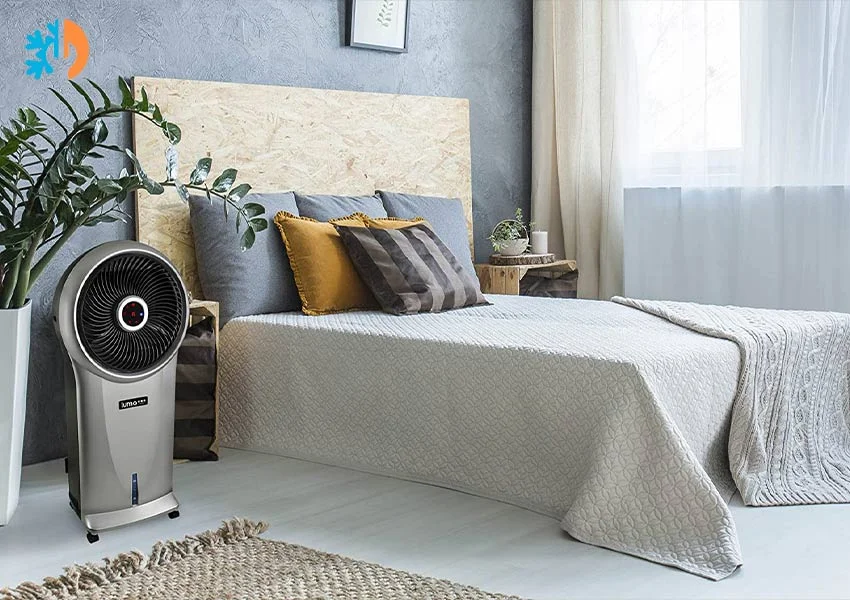
-
Split-system AC units (2 devices). Examples include central air conditioners, mini-split air conditioners, wall-mounted air conditioners, and ceiling air conditioners.
Advantages:
- Energy Efficiency: Split-system AC units are generally more energy-efficient than standalone units. They can cool larger areas and allow for more precise temperature control, which can lead to lower energy bills.
- Aesthetics: Split-system AC units are more aesthetically pleasing than window units or portable units as they don't require large openings in walls or windows. The indoor unit can be mounted high up on a wall or in the ceiling, leaving more floor space available.
- Quiet Operation: Split-system AC units are generally quieter than standalone units, as the compressor unit is located outside the building. This means that the only noise heard indoors is the sound of the fan, which is usually quite low.
Disadvantages:
- Installation Cost: Split-system AC units are generally more expensive to install than standalone units. This is because they require a professional to install both the indoor and outdoor units, which can be time-consuming and costly.
- Maintenance: Split-system AC units require regular maintenance to ensure they are working efficiently. This includes cleaning the filters, checking the refrigerant levels, and ensuring that the outdoor unit is clear of debris.
- Limited Cooling Capacity: Split-system AC units are not suitable for cooling large areas, such as entire houses. They are best suited for cooling individual rooms or small areas.
-
Both stand-alone and split-system Both stand-alone and split-system. Examples include smart air conditioners and geothermal air conditioners.
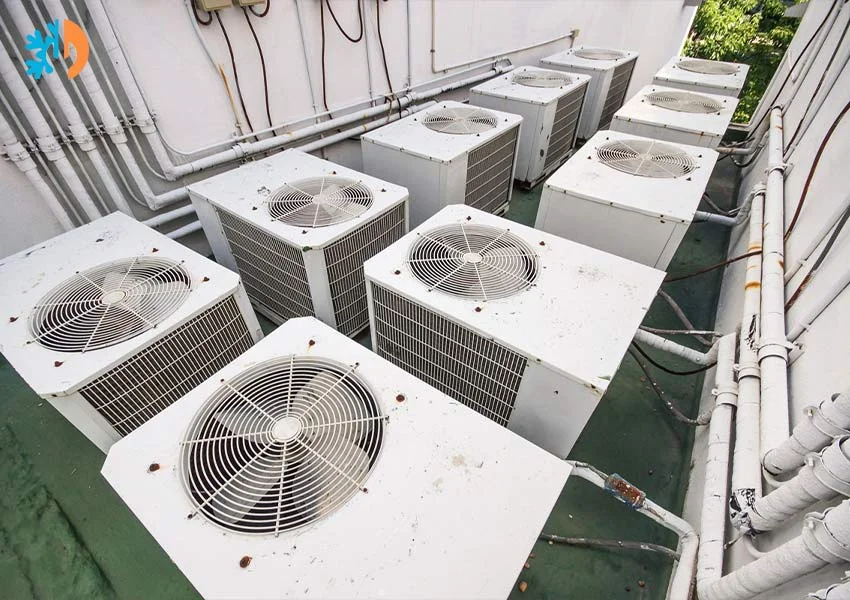
A. Stand-Alone AC Units (5 Different Types)
Stand-alone AC units are air conditioning systems that consist of a single device. These units are designed to cool a single room or a small area and are often portable. They do not require any installation and can be easily moved from one location to another. Stand-alone AC units are generally less expensive than split-system AC units, but they are not as efficient and are not suitable for cooling large areas. There are several types of these monoblock air conditioners:
A-1. Portable Air Conditioning (mobile air conditioners)
Mobile air conditioners and portable air conditioning units are the same thing. The terms "mobile" and "portable" are often used interchangeably in reference to these types of air conditioners.
Portable air conditioning units are compact and mobile devices that are designed to cool a room or area by removing heat and humidity from the air. They are particularly useful for spaces where a window air conditioning unit cannot be installed, such as apartments, small offices, or other areas that have limited space.
Portable air conditioners typically work by pulling in warm air from the room and passing it over a cooling coil filled with refrigerant, which cools the air. The cooled air is then blown back into the room through a vent. The hot air generated by the cooling process is vented outside through a hose that attaches to a window or vent.
When selecting a best portable air conditioner, it's important to consider the size of the room you want to cool, as well as the unit's cooling capacity, energy efficiency, noise level, and other features such as programmable timers, remote control, and air filters.
While portable air conditioners can be a convenient and cost-effective way to cool a room, they may not be as efficient as a central air conditioning system. Additionally, they can be noisy and may require regular maintenance, such as cleaning or replacing filters, to ensure optimal performance.
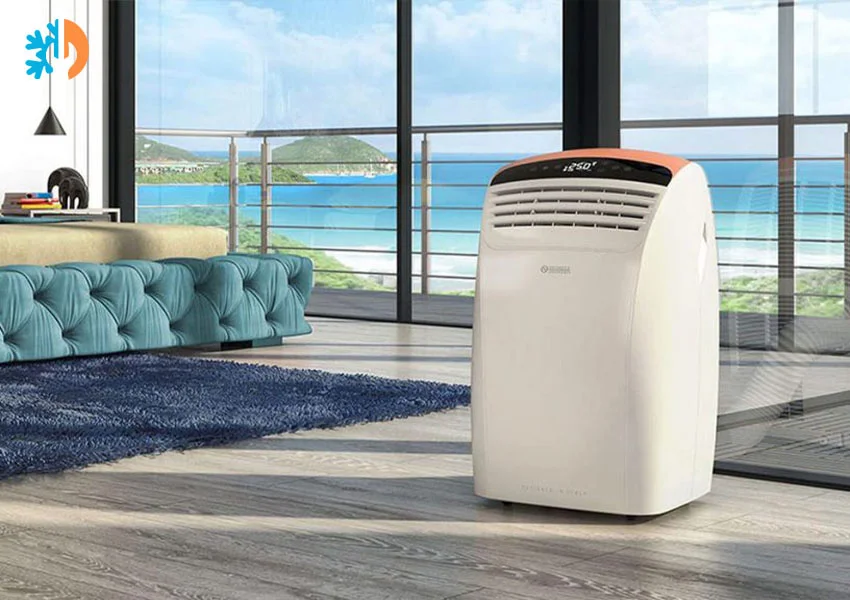
A-2. Window Air Conditioning
Window air conditioning is another type of stand-alone AC unit that is designed to cool a single room or a small area. As the name suggests, this type of unit is installed in a window and is fixed in place. Window air conditioners work by drawing warm air from the room and passing it over a cooling coil that contains refrigerant.
The cooled air is then released back into the room, while the warm air and moisture are expelled outside through the back of the unit. Window air conditioners are available in a variety of sizes and cooling capacities to suit different room sizes, and some models also have additional features such as air purifiers and timers.
One of the main benefits of window air conditioning is that it can be a more affordable option compared to other types of air conditioning systems.
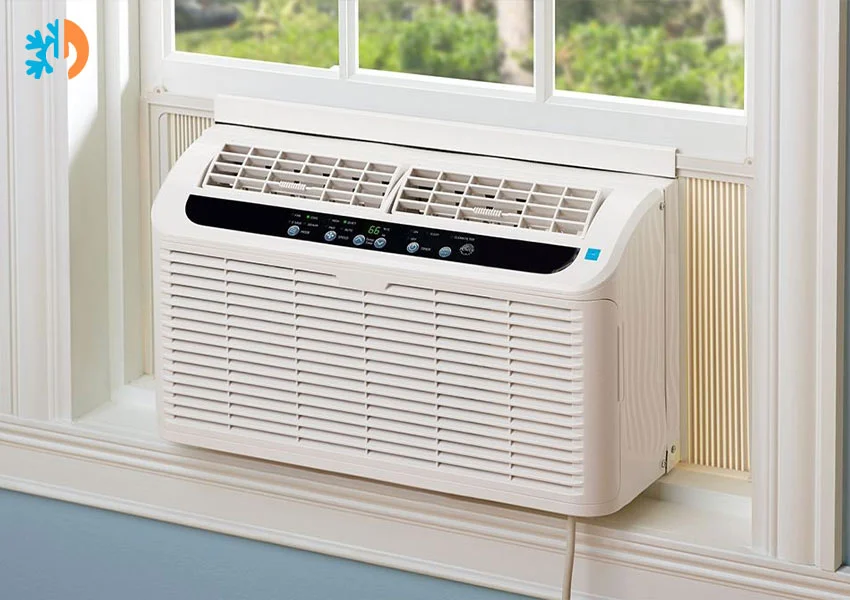
A-3. Wall-Mounted AC Units(thru-the-wall air conditioners)
Wall-mounted air conditioners, also known as thru-the-wall air conditioners, are similar to window air conditioners in that they are a type of stand-alone unit designed to cool a single room or area.
However, unlike window units that are installed in a window, wall-mounted units are mounted directly into the wall. This can be a good option for spaces where you may not have a suitable window or where you want a more permanent installation. Wall-mounted units also work by drawing in warm air from the room, passing it over a cooling coil containing refrigerant, and then releasing cooled air back into the room.
The warm air and moisture are expelled outside through the back of the unit. Wall-mounted air conditioners are available in different sizes and cooling capacities, and some models also have additional features such as timers and remote controls. They are often a more powerful option compared to portable or window air conditioners and can be used to cool larger rooms or multiple rooms in a home.
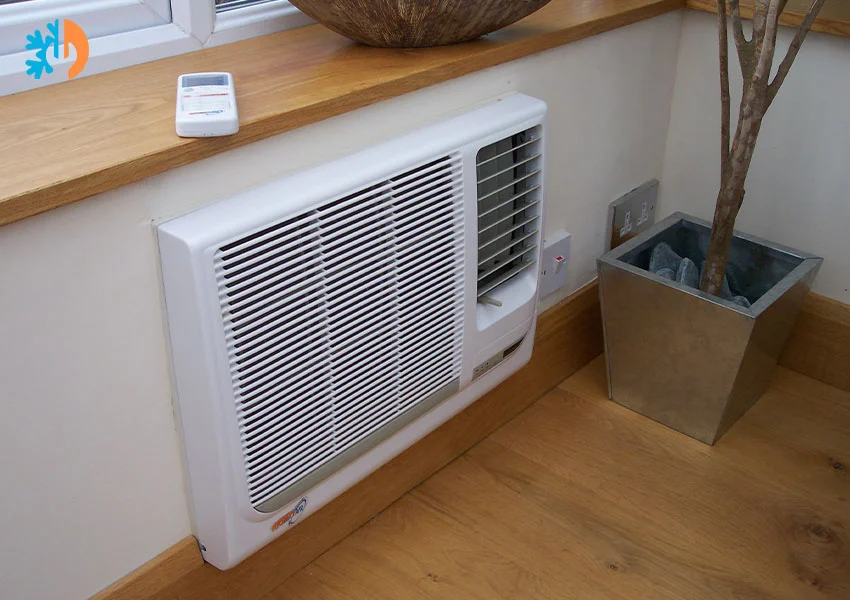
A-4. Personal air conditioners
Personal air conditioners are small, portable units that are designed to cool the immediate surrounding of an individual, typically a single person. They are also known as mini air conditioners or wearable air conditioners.
These devices are compact and can be worn on the body or placed on a desk or table. They are typically powered by batteries or USB cords and are designed to cool a small area, rather than an entire room or building.
Personal air conditioners are commonly used in offices, bedrooms, and outdoor activities such as camping or sporting events. They can also be useful for people who suffer from medical conditions that make them more sensitive to heat.
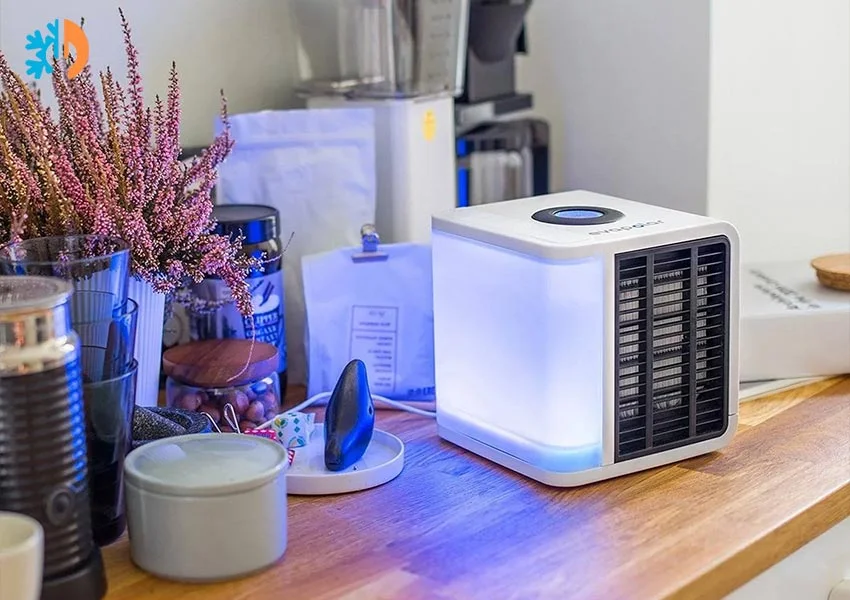
A-5. Spot Coolers For Boats and Ships
Spot coolers are a type of portable air conditioning unit that can be used to cool specific areas or rooms on board. These units are designed to be compact and easy to install, making them a popular choice for boat and ship owners who need to cool smaller areas or cabins.
Spot coolers for boats and ships typically work by drawing in warm air from the surrounding environment and passing it over a cooling coil that contains refrigerant. The cooled air is then released back into the room or area, while warm air and moisture are expelled outside through a hose or duct.
Some spot coolers for boats and ships may also have additional features such as timers, remote controls, and multiple fan speeds. They are available in various sizes and cooling capacities to suit different needs and requirements.
When choosing a spot cooler for a boat or ship, it is important to consider factors such as the size of the area that needs to be cooled, the power source available on board, and the installation requirements. Proper ventilation and drainage are also crucial to ensure that the unit operates efficiently and effectively.
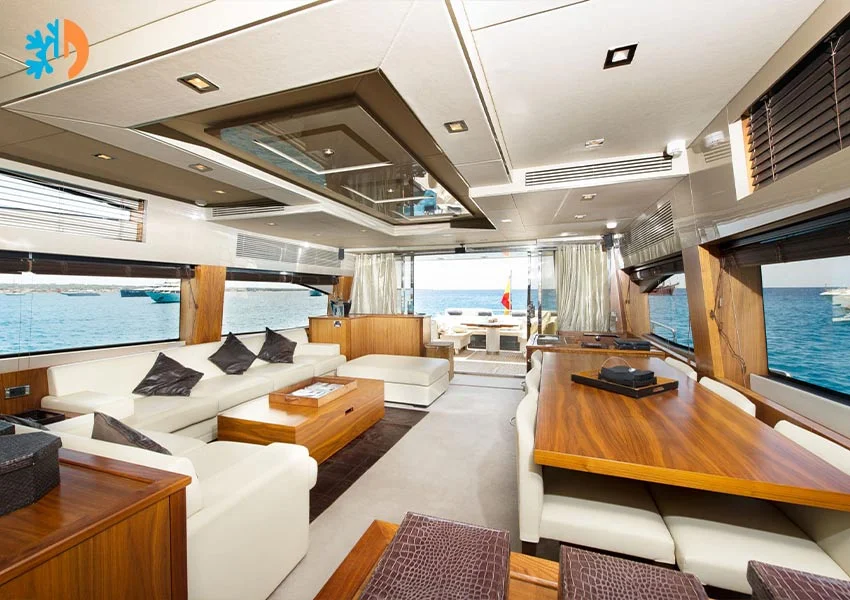
B- Split-System AC Units (11 Different Types)
Split-system AC units are air conditioning systems that consist of two main components, an indoor unit and an outdoor unit. The indoor unit contains the evaporator coil and the fan, while the outdoor unit houses the compressor, condenser coil, and fan. The two units are connected by a refrigerant line set, which circulates the refrigerant between the indoor and outdoor units.
Here are some examples of split-system air conditioners:
B-1. Wall Mounted Air Conditioners
Wall-mounted split system air conditioners, also known as ductless mini-split systems, are a type of split-system AC unit. They consist of an outdoor unit and one or more indoor units that are mounted on the wall of a room. These units are connected by a conduit that houses the refrigerant lines, power cables, and drainage pipes.
Wall-mounted split systems are a popular choice for cooling individual rooms or small spaces, as they offer high efficiency and flexibility in terms of installation and usage. They are also known for their quiet operation and sleek design, making them a popular choice for residential and commercial applications.
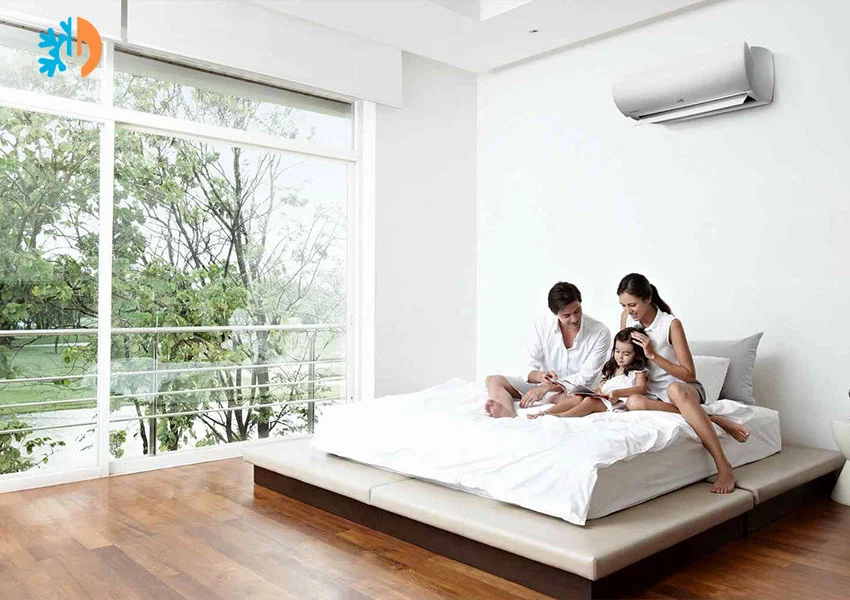
B-2. Under-Ceiling Type Of Air Conditioner (Cassette Air Conditioner)
Ceiling type air conditioner, also known as cassette air conditioner, is a type of split-system air conditioner that is installed in the ceiling. It is typically used in commercial and office spaces, but can also be found in residential settings.
The cassette air conditioner is designed to provide even and efficient cooling throughout the room by distributing cool air from four sides. It has a sleek and unobtrusive design that blends seamlessly with any interior decor. The cassette air conditioner is typically controlled by a remote control and has a range of features, including programmable timers and multiple fan speeds.
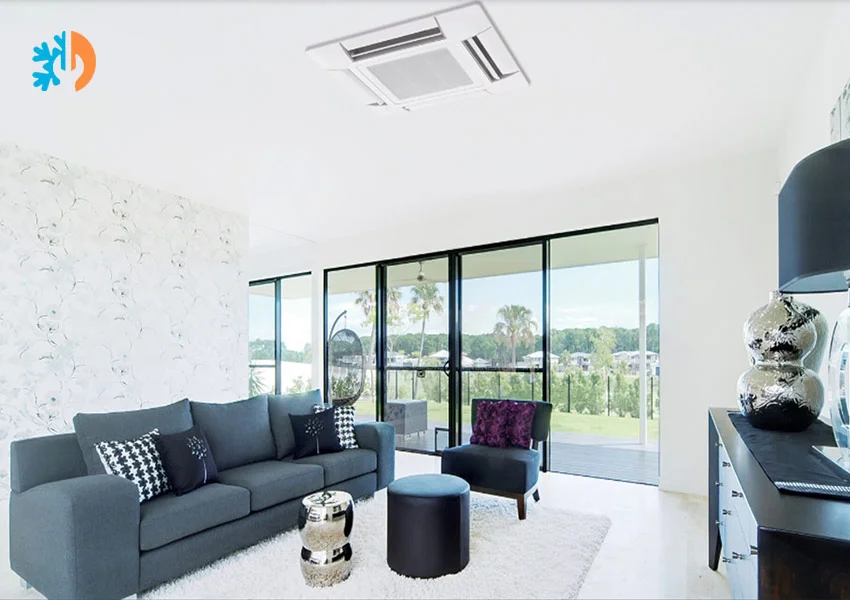
B-3. Ductless Mini-Split System Air Conditioners (Smart Air Conditioner)
Ductless mini-split system air conditioners, also known as a smart air conditioner, are a type of split-system AC unit. They consist of two main components, an outdoor unit and one or more indoor units.
The indoor units are mounted on the wall or ceiling and are connected to the outdoor unit through a small conduit that houses the power cable, refrigerant tubing, and condensate drain. This type of AC unit does not require ductwork to distribute cool air throughout the space, making it a popular option for retrofitting older homes or for adding cooling to specific rooms or zones in a larger building.
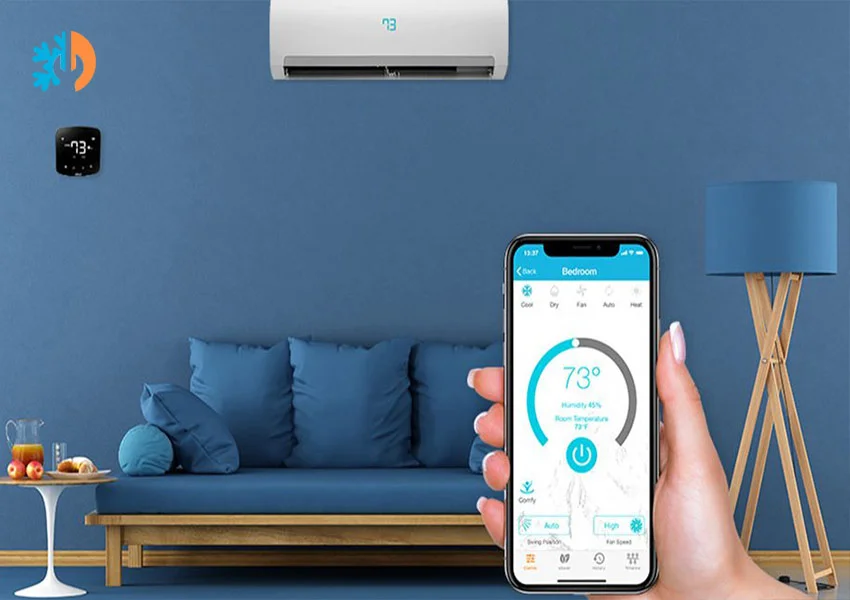
B-4. Central Air Conditioning
Central air conditioners are a type of split-system AC unit. They consist of two main components: an outdoor unit that contains the compressor, condenser, and fan, and an indoor unit that contains the evaporator coil and air handler.
The two units are connected by a refrigerant line and electrical wiring. Central air conditioners are designed to cool an entire home or building and are typically controlled by a thermostat. They are popular in areas with hot and humid summers, where they provide efficient and consistent cooling.
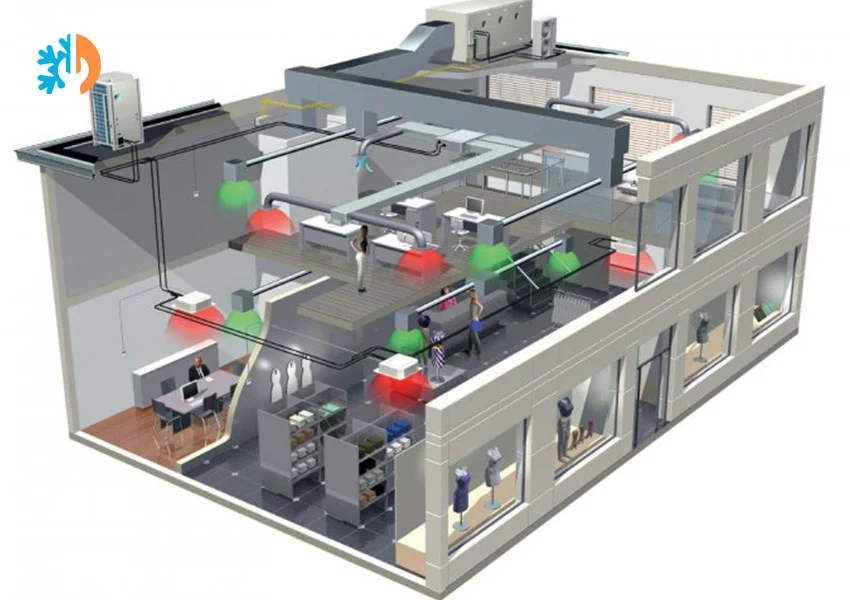
B-5. Ducted split system
A ducted split system, also known as a central air conditioning system, is a type of split system where the indoor unit is concealed in the ceiling or floor, and the conditioned air is distributed throughout the building via a ductwork system.
The outdoor unit is located outside the building and is connected to the indoor unit via refrigerant lines and electrical wiring. This type of system is ideal for larger buildings or homes where a centralized air conditioning system is required.
B-6. Multi-head split system
A multi-head split system is a type of air conditioning system where multiple indoor units are connected to a single outdoor unit. It allows for individual temperature control in different rooms or zones , making it a popular choice for homes or buildings with multiple rooms that require different cooling or heating needs. This type of system is considered a split system because it has both an outdoor unit and indoor units connected by refrigerant lines.
B-7. Dual split system
"Dual split system" is not a commonly used term in the air conditioning industry. It's possible that it refers to a type of split system that has two indoor units connected to one outdoor unit, similar to a multi-split system. However, without more information, it's difficult to provide a definitive answer.
B-8. VRV/VRF systems
VRV (Variable Refrigerant Volume) or VRF (Variable Refrigerant Flow) systems are types of HVAC (Heating, Ventilation, and Air Conditioning) systems that offer precise temperature control and energy efficiency in commercial buildings. They are often used in large buildings or complexes that require different heating and cooling zones, such as hotels, hospitals, or office buildings.
The VRV/VRF system consists of an outdoor unit that connects to multiple indoor units located in different areas or zones of the building. Each indoor unit can operate independently and provide heating or cooling as needed, allowing for customized temperature control in each area. The system uses a refrigerant to transfer heat between the indoor and outdoor units, which allows for high efficiency and low energy consumption.
VRV/VRF systems are known for their flexibility, efficiency, and ability to provide individualized comfort in large commercial buildings. They are often used as an alternative to traditional ducted systems, which can be less efficient and less customizable.
B-9. Hybrid split or Dual Fuel Air Conditioner system
A hybrid or dual fuel air conditioner is a type of split-system AC unit, as it has both an indoor and an outdoor component.
A hybrid or dual fuel air conditioner is a type of air conditioning system that combines two different types of heating sources. Typically, this includes a heat pump, which is used for cooling and heating in milder weather, and a backup furnace or boiler, which is used for heating in colder weather when the heat pump may not be efficient enough.
The system is designed to automatically switch between the two heating sources based on the outdoor temperature and other factors, in order to provide the most efficient and cost-effective heating and cooling for the home. This type of system is particularly useful in areas with fluctuating temperatures and varying energy costs, as it can help to reduce energy usage and save money on utility bills.
B-10. High-wall split system
A high-wall split system is a type of split system air conditioner that is mounted high up on a wall. It consists of two units: an indoor unit that is mounted on the wall inside the room and an outdoor unit that is installed outside the building. The indoor unit blows cool air into the room while the outdoor unit houses the compressor and circulates refrigerant to cool the air. High-wall split systems are popular for their ease of installation, energy efficiency, and quiet operation. They are commonly used in residential and commercial settings.
B-11. Evaporative Air Conditioner
Evaporative air conditioners, also known as swamp coolers, are a type of air conditioning system that cools the air by evaporating water. They work by pulling hot air from outside through moist pads or filters and blowing it back into the room as cool, humidified air. The moisture from the pads helps to cool the air as it evaporates, and the process can be very effective in dry climates. Evaporative air conditioners are generally more energy-efficient than traditional air conditioners, but they may not be as effective in humid climates.
Evaporative air conditioners are standalone units. They do not require any external compressor or condenser unit like split-system air conditioners do.
Conclusion
In conclusion, air conditioning systems play a crucial role in keeping indoor environments comfortable and cool. With several types of air conditioning systems available, it is essential to understand the differences between them to select the best option for a particular application. If you have one types of air conditioner and need to Air Conditioning Repairs, Cold Direct can help you.




